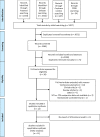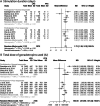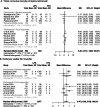ART outcomes following ovarian stimulation in the luteal phase:a systematic review and meta-analysis
- PMID: 34036454
- PMCID: PMC8417163
- DOI: 10.1007/s10815-021-02237-7
ART outcomes following ovarian stimulation in the luteal phase:a systematic review and meta-analysis
Abstract
Purpose: This study aimed to evaluate the impact of luteal phase ovarian stimulation (LPS) on the outcomes of assisted reproductive technology (ART) for infertile couples and patients desiring non-urgent egg cryopreservation.
Methods: We included all studies reported patients who received LPS and that used follicular phase ovarian stimulation (FPS) as a comparison group until January 2021. Prior meta-analysis regarding the outcomes of LPS in double stimulation and fertility preservation have already been published, so these studies were excluded. Risk of Bias in Non-randomized Studies of Interventions was used to assess the study quality. The study was registered in the International Prospective Register of Systematic Reviews database (CRD42020183946).
Results: Twelve studies with a total of 4433 patients were included. The regimen employed can be categorized into two groups, but there is currently no evidence to support one over the other. After we excluded the largest study, the clinical pregnancy rate and live birth rate were similar after FPS and LPS. There were significantly more stimulation days and total gonadotropins used in the LPS group. After subgroup analysis, we found that poor responders received significantly more cumulus oocyte complexes (+0.64) in the LPS group.
Conclusion: Current evidence indicates that patients in the LPS group could achieve pregnancy outcomes non-inferior to those in the FPS group. Because of current debate over freeze-all policy and the limited data about live birth rate, the universal use of LPS is considered controversial. In the future, more well-designed studies are necessary to investigate the indications for LPS and its cost-effectiveness.
Keywords: Luteal phase; Ovarian stimulation; Poor responders; Random start.
© 2021. The Author(s), under exclusive licence to Springer Science+Business Media, LLC, part of Springer Nature.
Conflict of interest statement
The authors declare no competing interests.
Figures




Similar articles
-
Growth hormone for in vitro fertilisation (IVF).Cochrane Database Syst Rev. 2021 Nov 22;11(11):CD000099. doi: 10.1002/14651858.CD000099.pub4. Cochrane Database Syst Rev. 2021. PMID: 34808697 Free PMC article.
-
Luteal phase support for women trying to conceive by intrauterine insemination or sexual intercourse.Cochrane Database Syst Rev. 2022 Aug 24;8(8):CD012396. doi: 10.1002/14651858.CD012396.pub2. Cochrane Database Syst Rev. 2022. PMID: 36000704 Free PMC article.
-
Individualised gonadotropin dose selection using markers of ovarian reserve for women undergoing in vitro fertilisation plus intracytoplasmic sperm injection (IVF/ICSI).Cochrane Database Syst Rev. 2018 Feb 1;2(2):CD012693. doi: 10.1002/14651858.CD012693.pub2. Cochrane Database Syst Rev. 2018. Update in: Cochrane Database Syst Rev. 2024 Jan 4;1:CD012693. doi: 10.1002/14651858.CD012693.pub3. PMID: 29388198 Free PMC article. Updated.
-
Home treatment for mental health problems: a systematic review.Health Technol Assess. 2001;5(15):1-139. doi: 10.3310/hta5150. Health Technol Assess. 2001. PMID: 11532236
-
Antioxidants for male subfertility.Cochrane Database Syst Rev. 2022 May 4;5(5):CD007411. doi: 10.1002/14651858.CD007411.pub5. Cochrane Database Syst Rev. 2022. PMID: 35506389 Free PMC article.
Cited by
-
Exploring new frontiers in oncofertility preservation: a case of ovarian stimulation during pregnancy.J Ovarian Res. 2025 Feb 26;18(1):39. doi: 10.1186/s13048-025-01615-4. J Ovarian Res. 2025. PMID: 40011966 Free PMC article.
-
Addition of intramuscular to vaginal progesterone for luteal phase support in fresh embryo transfer cycles: A cross-sectional study.Int J Reprod Biomed. 2022 Oct 10;20(9):745-752. doi: 10.18502/ijrm.v20i9.12064. eCollection 2022 Sep. Int J Reprod Biomed. 2022. PMID: 36340670 Free PMC article.
-
Clinical Application of Double Ovulation Stimulation in Patients with Diminished Ovarian Reserve and Asynchronous Follicular Development Undergoing Assisted Reproduction Technology.Curr Med Sci. 2023 Apr;43(2):304-312. doi: 10.1007/s11596-022-2687-0. Epub 2023 Mar 13. Curr Med Sci. 2023. PMID: 36913110
-
Retrospective study of influencing factors on the outcomes of luteal phase stimulation in patients with dual stimulation.PeerJ. 2023 May 5;11:e15296. doi: 10.7717/peerj.15296. eCollection 2023. PeerJ. 2023. PMID: 37168538 Free PMC article.
-
Smaller follicle diameter improves outcomes in natural LPOS: a retrospective cohort study.J Assist Reprod Genet. 2025 Apr;42(4):1287-1295. doi: 10.1007/s10815-025-03421-9. Epub 2025 Feb 11. J Assist Reprod Genet. 2025. PMID: 39934463
References
-
- Sfakianoudis K, Pantos K, Grigoriadis S, Rapani A, Maziotis E, Tsioulou P, Giannelou P, Kontogeorgi A, Pantou A, Vlahos N, Koutsilieris M, Simopoulou M. What is the true place of a double stimulation and double oocyte retrieval in the same cycle for patients diagnosed with poor ovarian reserve? A systematic review including a meta-analytical approach. J Assist Reprod Genet. 2020;37(1):181–204. doi: 10.1007/s10815-019-01638-z. - DOI - PMC - PubMed
Publication types
MeSH terms
Grants and funding
LinkOut - more resources
Full Text Sources
Other Literature Sources
Medical
Miscellaneous

